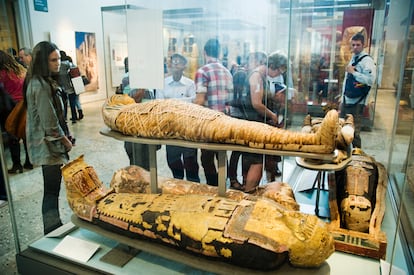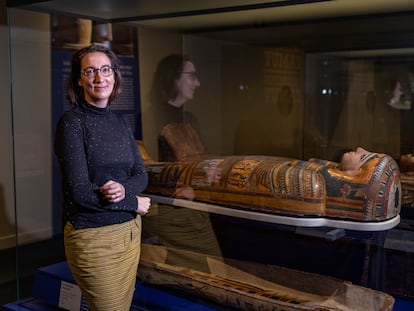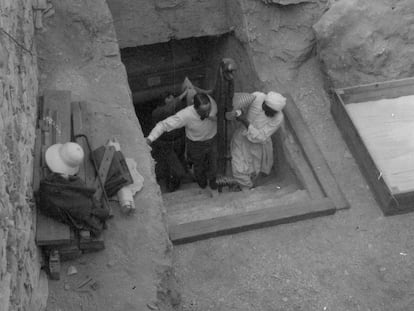British museums to stop using ‘mummy’ over negative associations
The word, say critics, has ties to imperialism and monsters, and should be replaced with ‘mummified remains.’ Conservatives are having a field day with the move

It’s not clear that Tutankhamun or Ramses II would appreciate the deference from the afterlife, but British museums are certainly providing plenty of material for conservative columnists who regularly gloat over wokeness or anything that sounds like political correctness. The British Museum in London, the National Museums of Scotland and the Great North Museum: Hancock have decided that, whenever possible, they will stop using the term “mummy” and speak instead of the “mummified remains of” the individual in question.
“The word ‘mummy’ is not incorrect, but it is dehumanizing, whereas using the term ‘mummified person’ encourages our visitors to think of the individual,” said a spokeswoman for National Museums Scotland in Edinburgh in statements to the Daily Mail, the tabloid newspaper that first reported the change.
Beyond the effectiveness of showing deference to human beings who died 6,000 years ago or more, the idea of changing the terminology also reflects the ongoing review of the United Kingdom’s colonial past. In a blog on the Great North Museum’s website, Jo Anderson, assistant keeper of archeology at the institution, writes about the atrocities to which the remains of Irtyru, one of two bodies on display in Newcastle, were subjected to. It is estimated that this woman died when she was between 30 and 35 years old, around the 7th century BC.
Napoleon’s Egyptian campaign, and all the archaeological remains he collected, revived interest in Ancient Egypt in Europe. A new wave of “Egyptomania” arose, leading to some deplorable practices such as the so-called “unwrapping parties” in which human remains obtained through looting would be unwrapped before an ecstatic public.
“In front of a ticketed audience, Irtyru was unwrapped and examined by three Newcastle surgeons – Thomas Michael Greenhow, John Baird and Sir John Fife,” wrote Anderson in her blog post. “It took two hours to unwrap, with bandages weighing 50lbs and 6ozs. After the autopsy, Irtyru’s body was prepared for display. A type of varnish known as shellac was applied as a form of protection – this is partly why Irtyru looks so dark today. As she was to be displayed upright in a ‘standing’ position, Irtyru was subjected to some severe violations – a large bolt and ring were attached through the cranium to enable her to be hung upright. At the same time, a large metal staple was inserted into Irtyru’s spine, which secured her to the baseboards of the coffin beneath.”
‘The Mummy’s Curse’
“The museum has not banned the term ‘mummy,’ and in fact it continues to be used in several of our galleries,” explained a spokesman for the British Museum in London, determined to add nuance to a decision that is beginning to provoke a cascade of criticism and irony. “But in recent exhibits we already use the expression ‘mummified remains of...’, and we include the name of the mummified person when we know it. It is about emphasizing the idea that the mummified remains belong to a human being who was once alive,” he adds.
But above all, the term “mummy,” thanks to literature and film, is now associated with monsters and curses that have nothing to do with the transcendental aspirations that the Egyptians sought in their funeral rites. The discovery in 1922 of Tutankhamun’s tomb in the Valley of the Kings, near Luxor, sparked a new furor over Ancient Egypt. The death of the expedition’s sponsor, Lord Carnarvon, and of some of those present when the funeral complex was opened (only six out of 26, and over the course of a decade), contributed to the legend of “the mummy’s curse.” Some suggest that this association was made even earlier, pointing out how the creator of detective Sherlock Holmes, Sir Arthur Conan Doyle, anticipated the fascination with mummies in his gothic horror tale Lot No. 249, in which Edward Bellingham, an Egyptology student, owns a mummy that disappears and reappears. The story, published in 1892, has been a source of inspiration for numerous later works in which mummies played a special role.
The museum debate, in any case, has also brought back to prominence Chris McGovern, a former high school principal, education adviser to the Conservative Party and chairman of the Campaign for Real Education lobby group, which calls for a return to the classrooms of values and traditional teaching contents. “The curse of the mummy is driving these academics mad!,” he told the Daily Mail.
Sign up for our weekly newsletter to get more English-language news coverage from EL PAÍS USA Edition
Tu suscripción se está usando en otro dispositivo
¿Quieres añadir otro usuario a tu suscripción?
Si continúas leyendo en este dispositivo, no se podrá leer en el otro.
FlechaTu suscripción se está usando en otro dispositivo y solo puedes acceder a EL PAÍS desde un dispositivo a la vez.
Si quieres compartir tu cuenta, cambia tu suscripción a la modalidad Premium, así podrás añadir otro usuario. Cada uno accederá con su propia cuenta de email, lo que os permitirá personalizar vuestra experiencia en EL PAÍS.
¿Tienes una suscripción de empresa? Accede aquí para contratar más cuentas.
En el caso de no saber quién está usando tu cuenta, te recomendamos cambiar tu contraseña aquí.
Si decides continuar compartiendo tu cuenta, este mensaje se mostrará en tu dispositivo y en el de la otra persona que está usando tu cuenta de forma indefinida, afectando a tu experiencia de lectura. Puedes consultar aquí los términos y condiciones de la suscripción digital.











































